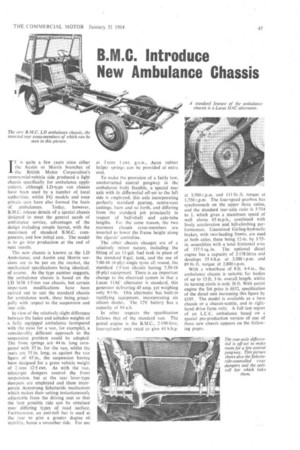B.M.C. Introduce New Ambulance Chassis
Page 49

If you've noticed an error in this article please click here to report it so we can fix it.
I1" is quite a few years since either the Austin or Morris branches of
the British Motor Corporation's commercial-vehicle side produced a light chassis specifically for ambulance applications, although LD-type van chassis have been used by a number of local authorities, whilst FU models and even private cars have also formed the basis of ambulances. Today, however, B.M.C. release details of a special chassis designed to meet the general needs of ambulance service, advantages of the design including simple layout, with the maximum of standard B.M.C. components, and low initial cost. The model is to go into production at the end of next month.
The new chassis is known as the LD Ambulance, and Austin and Morris versions are to be put on the market, the mechanical specifications being identical, of course. As the type number suggests, the ambulance chassis is based on the LD M30 1.5-ton van chassis, but certain important modifications have been carried out to suit the standard chassis for ambulance work, these being principally with respect to the suspension and rear axle.
ln view of the relatively slight difference between the laden and unladen weights of a fully equipped ambulance (compared with the ratio for a van, for example), a considerably different approach to the suspension problem could be adopted. The front springs are 44 in. long compared with 37 in. for the van, whilst the rears arc 55 in. long, as against the van figure of 45 in., the suspension having been designed for a gross vehicle weight of 2 tons 12.5 cwt. As with the van. telescopic dampers control the front suspension, but at the rear lever-type dampers are employed and these incorporate Armstrong Selectaride mechanism which makes their setting instantaneously adjustable from the driving seat so that the best possible ride can be obtained over differing types of road surface. Furthermore, an anti-roll bar is used at the rear to give a greater degree of. stability, hence a smoother ride. For use
at 3 tons 1 cwt. g.v.w., Aeon rubber helper springs can be provided at extra cost.
To make the provision of a fairly low, unobstructed central gangway in the ambulance body feasible, a special rear axle with its differential off-set to the left side is employed, this axle incorporating perfectly standard gearing, centre-case castings. hubs and so forth, and differing from the standard job principally in respect of half-shaft and axle-tube lengths. Fur the same reason, the two rearmost chassis cross-members are inverted to lower the frame height along the cliassiscentreline.
The other chassis changes are of a relatively minor nature, including the fitting of an 11-gal, fuel tank in place of the standard 8-gal. tank, and the use of 7.00-16 (6-ply) single tyres all round, the standard I'S-ion chassis having 7.50-16 (8-ply) equipment. There is an important change to the electrical system in that a Lucas I 1AC alternator is standard, this generator delivering 45 amp. yet weighing only 9-5 lb. This alternator has built-in rectifying equipment. incorporating six silicon diodes. The I 2V battery has a capacity of 64 a.h.
In other respects the specification follows that of the standard van. The petrol engine is the B.M.C., 2.199-litre, four-cylinder unit rated to give 61 b.h.p. at 3,500 r.p.m. and Ill Ih. ft. torque at 1,750 r.p.m. The four-speed gearbox has synchromesh on the upper three ratios, and the standard rear-axle ratio is 5-714 to 1, which gives a maximum speed of well above 65 m.p.h., combined with lively acceleration and hill-climbing performances. Unassisted Girling-hydraulic brakes, with two-leading fronts, arc used at both axles, these being 12-in. by 175in, assemblies with a total frictional area of 157.5 sq. in. The optional diesel engine has a capacity of 2.178 litres and develops 55 b.h.p. at 3,500 r.p.m. and 89 lb. ft. torque at 2,800 r.p.m.
With a wheelbase of 8 ft. 4.4 in., the ambulance chassis is suitable for bodies of up to 15 ft. 3 in. overall length, whilst its turning circle is only 36 ft. With petrol engine the list price is £632, specification of the diesel unit increasing this figure by £105. The model is available as a bare chassis or a chassis-scuttle, and in righthand drive form only. A full test report cif an L.C.C. ambulance based on a special pre-production version of one of these new chassis appears on the following pages.




















































































































